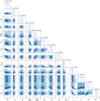| Issue |
A&A
Volume 682, February 2024
|
|
|---|---|---|
| Article Number | C1 | |
| Number of page(s) | 2 | |
| Section | Numerical methods and codes | |
| DOI | https://doi.org/10.1051/0004-6361/202245216e | |
| Published online | 22 February 2024 | |
GWSim: Python package for creating mock GW samples for different astrophysical populations and cosmological models of binary black holes (Corrigendum)
1
Institut de Física d’Altes Energies (IFAE), Barcelona Institute of Science and Technology,
Barcelona,
Spain
e-mail: ckarathanasis@ifae.es
2
Subatech, CNRS, Institut Mines-Telecom Atlantique, Nantes Université,
44000
Nantes,
France
3
Université Paris Cité, CNRS, Astroparticule et Cosmologie,
75000
Paris,
France
4
Department of Astronomy & Astrophysics, Tata Institute of Fundamental Research,
1, Homi Bhabha Road, Colaba,
Mumbai
400005,
India
5
Institute of Gravitational Research (IGR), University of Glasgow,
Glasgow,
UK
Key words: gravitational waves / methods: numerical / errata, addenda
Figure 5 presents the hierarchical inference of cosmological and population parameters using mock gravitational-wave data produced by GWSim. These data were obtained using a Bayesian analysis that relies on parameter estimation (PE) prior assumptions on the parameters of interest. The result shown in the original figure assumed incorrectly that the PE priors were on the detector-frame masses (m1, m2) of the two black holes when the actual PE priors were on detector-frame chirp mass, ℳc, and mass-ratio q = m2/m1. The result shown in the new figure uses the correct PE priors: the difference is the presence of an additionnal Jacobian, ℐ, such that  . The principal effect is visible in the estimation of the hyper-parameter, β, which is recovered much better with respect to the original results.
. The principal effect is visible in the estimation of the hyper-parameter, β, which is recovered much better with respect to the original results.
© The Authors 2024
 Open Access article, published by EDP Sciences, under the terms of the Creative Commons Attribution License (https://creativecommons.org/licenses/by/4.0), which permits unrestricted use, distribution, and reproduction in any medium, provided the original work is properly cited.
Open Access article, published by EDP Sciences, under the terms of the Creative Commons Attribution License (https://creativecommons.org/licenses/by/4.0), which permits unrestricted use, distribution, and reproduction in any medium, provided the original work is properly cited.
This article is published in open access under the Subscribe to Open model. Subscribe to A&A to support open access publication.
All Figures
 |
Fig. 5 Population and cosmological parameter posteriors obtained from an O1-, O2-, O3-, and 04-like simulation using the cosmological inference python package IcaroGW. The red lines indicate the injected values of the parameters. |
| In the text | |
Current usage metrics show cumulative count of Article Views (full-text article views including HTML views, PDF and ePub downloads, according to the available data) and Abstracts Views on Vision4Press platform.
Data correspond to usage on the plateform after 2015. The current usage metrics is available 48-96 hours after online publication and is updated daily on week days.
Initial download of the metrics may take a while.


